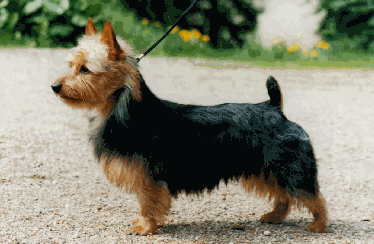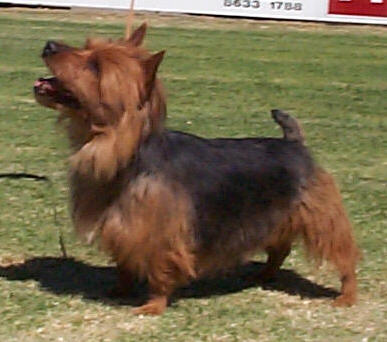
The Breed Standard
General Appearance:
A sturdy low-set dog, rather long in proportion to height with strong Terrier character, alertness, activity and soundness. Its untrimmed, harsh coat with definite ruff around the neck extending to the breastbone and its long strong head assist in developing its hard bitten, rugged appearance.
Characteristics: (Not specified.)
Temperament:
Essentially a working terrier, but its loyalty and even disposition make it equally suitable as a companion dog.
Head And Skull:
Long with flat skull of moderate width,
full between the eyes, and slight but
definite stop.
The muzzle, strong and powerful, equal in length to th at of
at of
the
skull, which is covered with a soft topknot.
The muzzle must be strong and not fall away under the eyes.
Nose:
black, of moderate size, the leather extending to the
bridge of muzzle.
Eyes:
The eyes
shall be small, oval, with keen expression, and of
dark brown colour, set well apart and not prominent.
Ears:
The ears are small, erect, pointed, well carried,
set
on moderately wide, free from long hair and sensitive
in their use (puppies under six months excepted).
Mouth:
Jaw strong and punishing, teeth large and evenly spaced, the upper incisors fitting closely over the lower (scissor bite), lips black, tight and clean. The length and strength of muzzle are essential to give the strong, punishing jaw.
Neck:
The neck is of good length, slightly arched, strong and flowing into the well angulated shoulders.
Forequarters:
The forechest is well developed, brisket relatively deep with forelegs well boned, straight and parallel when viewed from the front. Pasterns are strong, without slope. The legs are slightly feathered to the knee.
Body:
Long in proportion to height, strongly constructed, with well sprung ribs and chest of moderate depth and width. The topline is level with loins strong and deep flanks. In considering the body, attention must be paid to the opening description, "a sturdy low set dog, rather long in proportion to height".
Hindquarters:
Moderate length of quarters, broad with strong muscular thighs. Stifles are well turned with hocks well bent and let down. Viewed from behind they should be parallel from hock to feet, neither too wide nor too close.
Feet:
Small, round, compact, well padded, toes closely knit and moderately arched. Turned neither in nor out, with strong black or dark toenails.
Tail:
Not docked, set on high, and
well carried
Gait/Movement:
The action to be free, true, springy and forceful. When viewed from the front, the forelegs should move truly without looseness of shoulder, elbows or pasterns. The hindquarters to have drive and power, with free movement of stifles and hocks. Viewed from the rear the legs from the hocks to the ground to be parallel, neither too close nor too wide.
Coat:
The body coat consists of a harsh straight dense top coat approximately 6 cms (approximately 2.5 ins) long with short soft textured undercoat. The muzzle, lower legs and feet to be free from long hair.
Colour:
Blue, steel blue or dark grey blue, with rich tan (not sandy) on face,
ears, under body, lower legs
and  feet and around the vent (puppies excepted). The richer the colour and more
clearly defined the better. Smuttiness is objectionable. Topknot blue, silver
or a lighter shade than head colour.
feet and around the vent (puppies excepted). The richer the colour and more
clearly defined the better. Smuttiness is objectionable. Topknot blue, silver
or a lighter shade than head colour.
Clear sandy or red. The topknot of a similar or lighter shade. Any dark
shadings or smuttiness undesirable.
In any colour, white markings on chest or feet must be penalised.
Sizes: Height: Dogs approx.
25 cms (approx. 10 ins.) at the withers,
Bitches slightly less
Weight: Dogs approx. 6.5 kg (approx.
14 lbs); Bitches slightly less.
Faults: Any departure from the foregoing points should
be considered a fault and the seriousness with which the fault should be
regarded should be in exact proportion to its degree and its effect upon the
health and welfare of the dog.
Notes: Male animals should have two apparently normal testicles fully descended into the scrotum.
Chocolate Coloured Australian Terriers
This is not in the defining Standard of the Breed, and is not correct in a pure bred Australian Terrier today.
After researching the colour with experienced older breeders and reference books, it seems that ‘Chocolate ‘ dogs appeared in the late 1940s, often with white feet as well. There were rumours of imported dogs being used in the breeding, mainly the Irish Terrier, to improve heads and coats. It was strongly rumoured, but no one would admit it publically.
The ’Chocolate Aussie’ today is caused by a recessive genes from old blood lines doubled up in the breeding - it is an indication that some of its ancestors were cross-breeds. The cross mating from the Irish Terriers also produced aggression in the breed. Recessive genes can be hidden and passed down in successive generations for many years.
Cross colour matings were often done, and the Aussies that were remembered as having smutty or grizzly coats were those of almost blue and tan ancestry. However, when interbreeding of the two colours is attempted for valid reasons of type, conformation or temperament, research has shown the resulting progeny should be bred true to colour for no less than the next three generations.
From Pam Douglas’ book The Australian Terrier:
In the red and sandies that were never cross-coloured., eventually the pigmentation was diluted to the point of producing light brown eyes, toe nails and pink eye rims and lips. Interestingly, test matings researched have revealed that after the third or fourth generation of repeated cross colour matings, a large percentage of adult coats in both the sandies and reds and the blue and tans had the wrong coloured undercoats and were very smutty. So called ‘chocolate puppies’ were then seen. Ed.
